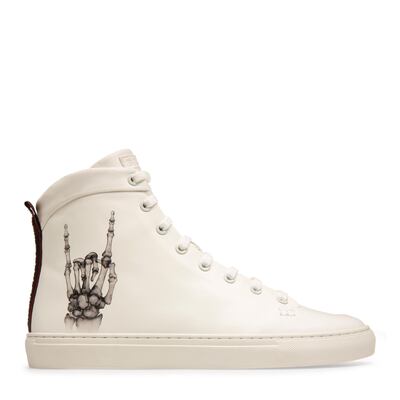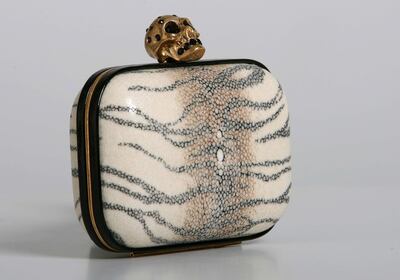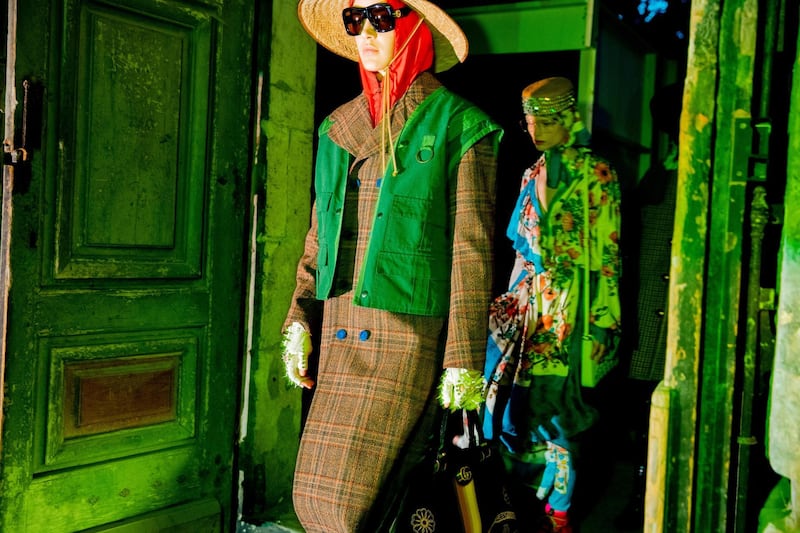Fashion has long been obsessed by morbid imagery and its visual representation. In Victorian England, mortality was a part of everyday life. Without the benefit of modern medicine, life expectancy was half of what it is today, giving rise to a death culture. Women dressed entirely in black for years after the passing of a loved one, carrying around locks of hair, bones or ashes locked inside pretty filigree jewellery, known as memento mori. Queen Victoria was the driver of mourning fashion, wearing black for 40 years after the death of her husband, Albert.
Today, death is often far removed from regular lives; nevertheless, we continue to be intrigued by the visual expression of our morbid curiosity. Literature, music, art, theatre, dance and advertising are littered with images of death and its symbols. Skull and crossbones are the symbols of choice for gangs, punk-rockers and goths. We celebrate Halloween and Dia de Muertos (Mexico's day of the dead). We have mythologised, glamourised and romanticised death – from Shakespeare's Romeo and Juliet to the Twilight Saga. Immaculately dressed models posing as corpses routinely adorn the pages of fashion magazines.
The Metropolitan Museum of Art in New York mounted an exhibition on mourning dress entitled Death Becomes Her in 2014, and the museum at the Fashion Institute of Technology exalted fashion inspired by the darker side of life entitled Dark Glamour, and featured Gothic-inspired fashion from the likes of Rick Owens, John Galliano, Comme Des Garcons and, of course, Alexander McQueen.

Ralph Lauren, Tom Ford, Gareth Pugh, Martin Margiela, Hussein Chalayan, Thom Browne, H&M, Vivienne Westwood and Viktor & Rolf have all infused their collections with lurid imagery. Fashion photography greats Annie Leibovitz and Steven Meisel have shot major editorials for the likes of Vogue featuring "corpse chic". Skulls, crossbones and other associated imagery even adorn pyjamas, bedding, lunch boxes and baby clothing.
You can't discuss corpse chic without referencing Alexander McQueen – the brilliant British designer whose fascination with the dark side of beauty inspired one brilliant collection after another. McQueen is infamous for adorning clothing and accessories with images of skulls; he has used them as clutch-bag closures, bangles, earrings and sunglass decoration. He based a collection on Marie Antoinette's confinement prior to her execution, and others on film noir genius Alfred Hitchcock's Vertigo and The Birds.

Rick Owens is also known to have an ongoing love affair with darkness. Labelled the "Prince of Dark Design", the cult Californian designer who lives in Paris, often produces full collections almost entirely in black. His designs masterfully combine elegance with barbarity, expressed through frayed edges and laddered knits. The ultimate rebel, the designer is often considered goth, with his long black hair and his abiding love of the colour black. His collections often utilise historical and biblical visual codes, juxtaposed with subversive undertones.
Dutch fashion designer Iris van Herpen, best-known for fusing technology and experimental techniques, has often tinged her collections with the bizarre and the dark. She has referenced extraterrestrials, internal organs and skeletons through her designs. Her exoskeleton dress is perhaps her single most renowned and impactful design, depicting a fantastical external bone structure surrounding the body. She was the first designer to successfully incorporate 3D printing into high fashion and is also known for her commitment to continuous innovation.
Designer Ricardo Tisci, creative director for Givenchy for 12 years prior to his move to Burberry, often adorned his models in black lace and metre upon metre of rustling black taffeta. He is associated with an edgy, streetwise Gothic aesthetic, and noted for injecting darkness into the brand through his use of religious iconography in his work.

His collection featured languid silhouettes that balanced darkness with purity, and fragility with strength, often expressed through monochromatic Victorian references.
Gucci's 2019 cruise collection proves our fascination with the darker side of life is ongoing, and not a passing trend. Always on the cutting edge, Gucci's cruise collection takes place in a different location every time. This year's collection was shown in a Roman-era necropolis in Arles, France, surrounded by moss-covered graves dating back to the fourth century. The catwalk was divided by a line of flames, and bordered by rows of church candles, complementing the velvet shrouds and black moire capes that were interspersed throughout the collection.
Perhaps the genius of good design is represented by the likes of these designers who artfully balance beauty and perfection with our fascination for the macabre.Perhaps the genius of good design is represented by the likes of these designers who artfully balance beauty and perfection with our fascination for the macabre.











